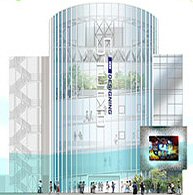KDDI Designing Studio: Video Tour
 Japan’s wireless industry provides some of the coolest mobile experiences on planet Earth. It should come as no surprise, therefore, that mobile players here are also masters at the street-level marketing of cell phones and wireless services — and KDDI’s Designing Studio is not only the latest over-the-top effort at creating a consumer-targeted mobile funland, it’s also the best. In today’s program, WWJ’s Gail Nakada speaks with the Studio’s general manager, tours five floors’ worth of interactive games, live handsets and mobile demos, and plugs into Harajuku’s ultimate mobile zeitgeist.
Japan’s wireless industry provides some of the coolest mobile experiences on planet Earth. It should come as no surprise, therefore, that mobile players here are also masters at the street-level marketing of cell phones and wireless services — and KDDI’s Designing Studio is not only the latest over-the-top effort at creating a consumer-targeted mobile funland, it’s also the best. In today’s program, WWJ’s Gail Nakada speaks with the Studio’s general manager, tours five floors’ worth of interactive games, live handsets and mobile demos, and plugs into Harajuku’s ultimate mobile zeitgeist.


 KDDI has opened an Alpha Pup playland for its mobile universe right in the heart of Tokyo fashion central — Harajuku. Five floors of interactive phones and games,
KDDI has opened an Alpha Pup playland for its mobile universe right in the heart of Tokyo fashion central — Harajuku. Five floors of interactive phones and games,